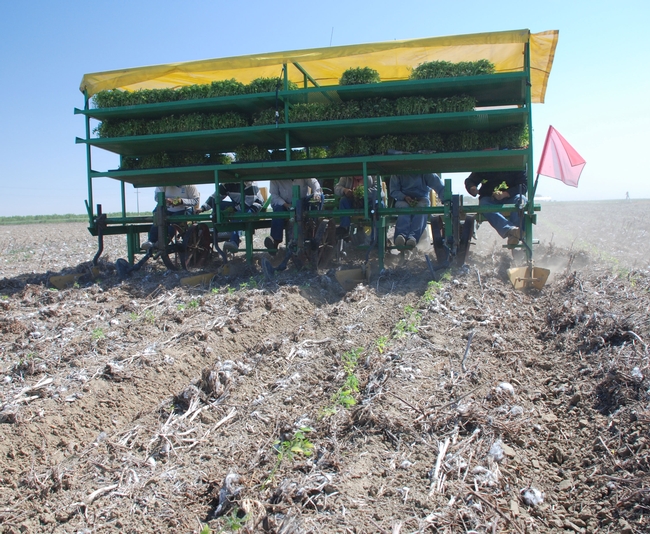UC Blogs
Behold, the Gold!
When you visit the Häagen-Dazs Honey Bee Haven on Bee Biology Road, University of California, Davis, be sure to check out the...
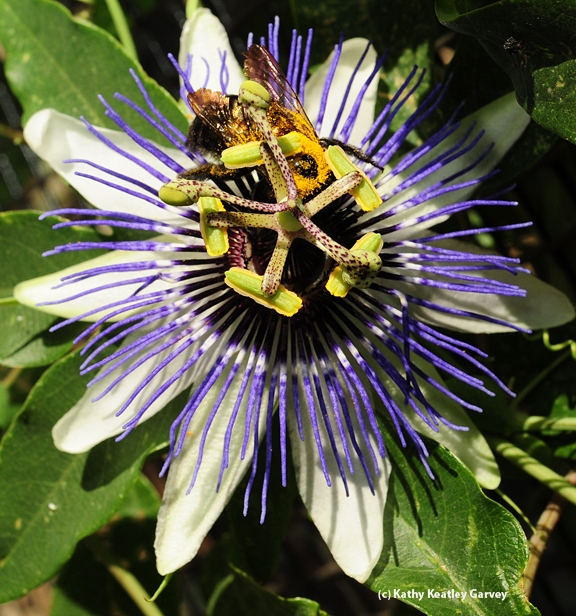
Valley carpenter bee foraging on a passion flower. (Photo by Kathy Keatley Garvey)
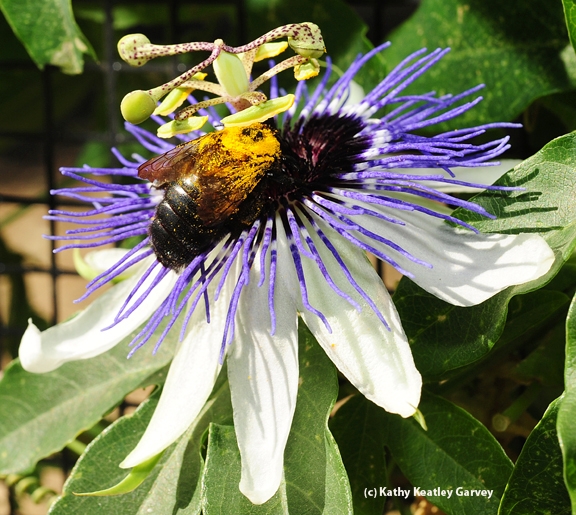
Note the golden pollen on the Valley carpenter bee. (Photo by Kathy Keatley Garvey)
Walnut pest management: Recent publications in 2012 and 2013
A comprehensive search for pest related publications in 2012 and 2013 revealed a few papers of broad interest to researchers working with...
'Thought for food' chews on conservation agriculture
Blogger Nathanael Johnson, who writes 'Thought for food' on the Grist website, recently contemplated the impacts of reduced soil tillage on the use of chemical herbicides and crops genetically engineered to tolerate herbicide applications.
He noted that the practice of tillage in farming does not mimic nature.
"Nature only rarely turns the land upside down — only during disasters," Johnson wrote. "This ecosystem (soil) responds to being turned upside-down the same way a rainforest would: It falls apart."
However, the author wondered whether the development of herbicide-tolerant crops has led farmers to adopt conservation tillage. For an answer, he turned to Jeff Mitchell, UC Cooperative Extension specialist in the Department of Plant Sciences at UC Davis.
“I’ve heard farmers here in California say that Roundup resistant crops effectively allowed some people to start doing conservation tillage,” Mitchell said. “But you have to remember, the vast majority of farmers in the U.S. using Roundup Ready seed don’t do conservation tillage.”
Garrison Sposito, professor in the Department of Environmental Science, Policy and Management at UC Berkeley, said genetically modified crops and herbicide use aren't required for conservation agriculture, but without them, yields go down.
"You never solve problems by making changes,” Sposito said. “What you do by making changes is exchange one set of problems for another set of problems.”
Have GMOs triggered conservation-minded agriculture? In the U.S., just a little bit, Johnson concluded.
Ultimate Swarms
It was blazing hot that summer day in Winters, Calif. The date: July 22, 2012. The place: a sunfiower field in Winters, Calif. We watched as a BBC...
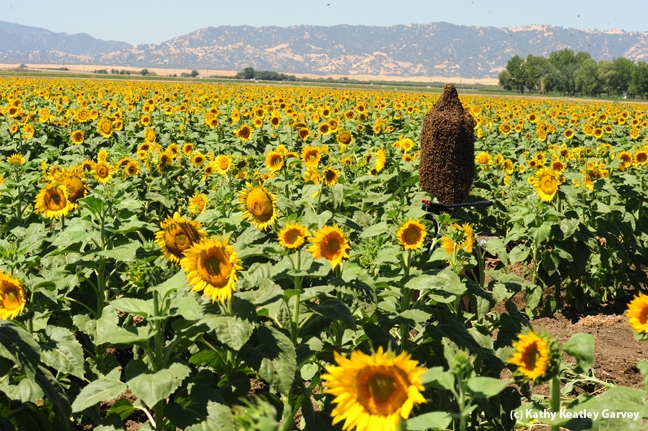
Norm Gary's bee cluster in the middle of a sunflower field in Winters. (Photo by Kathy Keatley Garvey)
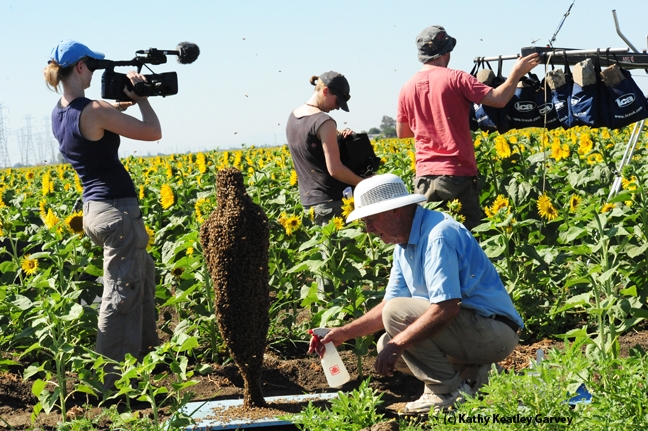
BBC crew sets up in a Winters' sunflower field, as Norm Gary sprays sugar water on his bee cluster. (Photo by Kathy Keatley Garvey)
Are You a Future Master Gardener?
A year ago I was sitting at home looking through the community calendar in the local monthly penny saver when I saw the application deadline for the Solano Master Gardener program. Curious about the program, I went to the website to read more about it which sounded interesting. Not considering myself to be a “real” gardener, since my experience was limited to annually growing a summer vegetable garden, it looked like a great opportunity to learn more about gardening. I never took a horticulture class, or even took the time to read any gardening books, but I decided it wouldn’t hurt to fill out the application for the program. I never imagined a year later I would be writing this blog post as a Master Gardener.
The initial knowledge, background, and experiences of individuals in each new class of Master Gardeners is different. We each journey through the program for different reasons. But upon graduation, we share a common knowledge, and a common goal of providing research based home horticulture information to the community.
Are you a potential future Master Gardener? Can you answer “yes” to any of these questions?
- Do you like gardening?
- Do you like helping others?
- Do you like learning new things?
- Do you like growing your own fruits and vegetables with little or no use of pesticides?
- Do you care about sustaining the land and the environment?
- Do you enjoy the company of like minded people?
- Are you interested in helping your community?
- Are you looking for a fun, meaningful volunteer opportunity?
If you answered yes to one or more of these questions, then consider applying for the 2014 Master Gardener class. There’s still time to apply before the October 31st deadline.
The benefits of being a Master Gardener are numerous. First, you’ll receive 16 weeks of horticultural education covering topics ranging from turf and landscape trees to weeds, water management, and entomology. The classes are taught by University of California and other local faculty, providing you with first class instruction. You’ll receive a copy of the 700 page California Master Gardener Handbook and a copy of the book Pests of Landscape Trees and Shrubs. On an ongoing basis you’ll receive information about upcoming horticulture related talks, workshops, webinars and other opportunities to expand your knowledge. And you’ll have access to UC research on horticultural topics of interest to home gardeners.
The Master Gardener program is a volunteer program so as a Master Gardener, you are required to provide a minimum number of approved volunteer hours in the community on an annual basis. But until I became a Master Gardener, I had no idea of the scope of the volunteer opportunities available. They are bountiful and the best part is you have the opportunity to choose only those that interest you. For example volunteer opportunities include providing gardening information to school children at special events, or working with children during library events presented by Master Gardeners, answering gardening questions at local farmers markets, providing training on composting, presenting a gardening talk at the library or other venue, helping maintain the Children’s Memorial garden, gardening with juvenile detainees at the New Foundations Juvenile Hall garden, or writing for the blog or newsletter. These are just some of the many community volunteer opportunities available to you as a Master Gardener.
If you’re interested in joining the camaraderie of over 100 Master Gardeners in Solano County, be sure to submit your application for the class of 2014 before the October 31st deadline. The application is accessible at http://cesolano.ucanr.edu.
If you have any questions about the application process or program, contact the Program Coordinator Jennifer Baumbach at (707) 784-1321 or jmbaumbach@ucanr.edu.
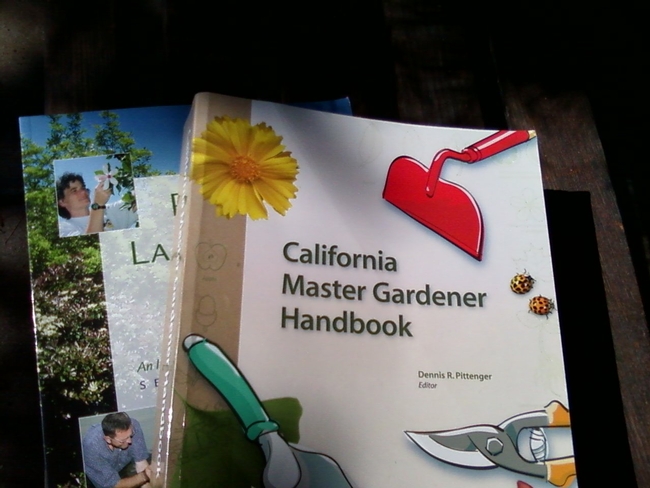
California Master Gardener Handbook and Pests of the Landscape Trees and Shrubs manuals. (photo by Kathy Low)


